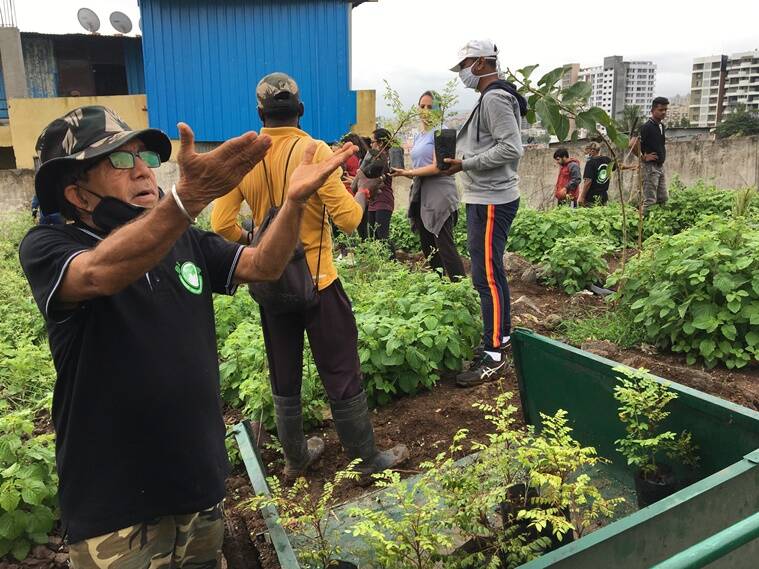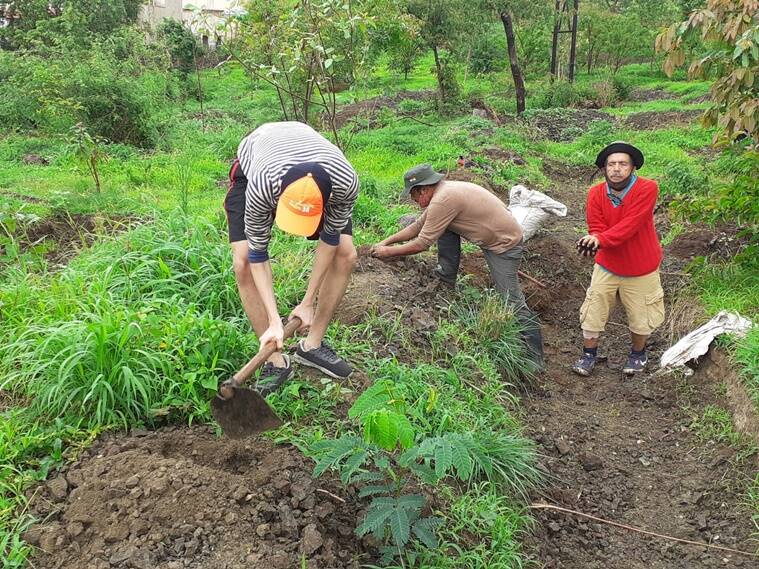Locally known as ‘tekdi’, a 33-acre hill in Pune’s Kondhwa was used as a dumping ground for decades as trucks deposited construction, medical and household waste there from across the city. In July 2013, Praveen Kumar, the general manager of a pharmaceutical company in Delhi, moved to Pune after retirement and went for a walk in the area with his wife. Within minutes of approaching the tekdi, he started vomiting. There was smelly water on which things were floating and 20-30 ft mounds of garbage. Kumar returned home, took medicines and rested. Then, he went back; this time, armed with buckets and dustbins.
What followed is a citizens’ movement that is fighting back global warming and groundwater depletion in Pune the hard way — by turning a barren space into a lush forest called Anand Van (Forest of Happiness). “A group of people volunteered and did some good work. We are with them in their efforts to make the city green. Everybody in Pune can feel the rising heat so we need to plant as many trees as possible and turn the hills in Pune green. Direct participation of people is most welcome,” says Praveen N R, the chief conservator of forests, Pune. The group working to raise the forest is called Anand Van Mitra Mandal.
 Pravin Kumar and team at work at Anand Van. (Express photo)
Pravin Kumar and team at work at Anand Van. (Express photo)
Putting down roots
Kumar, who was born in Dehradun and brought up in Haridwar, believes in social causes. In Pune, he began to visit the dump yard every day to clean it up by himself. “It is the feeling with which you work that determines the result. Even if you don’t get the desired result, it is ok,” he says.
Kumar began to stand on the roadside and talk to walkers, trekkers and students about his vision to green the area. Among those paying attention were M V Thomas, who also lives in the area, and Bhupesh Sharma, an employee with an IT firm. They pitched in, collecting funds, machinery and people for the project. Realising that removing all the trash would take a lifetime, a decision was taken to flatten it and plant over it.
On March 24, 2014, the project saw its first plantation drive – 24 jamun saplings that failed to grow because there was no water. The group tried its luck with more saplings but these too died. It was the first time that Kumar and the other volunteers were building a forest so they underwent training. They picked up tips, such as making the pits larger and getting certain tools and implements.
 Anand Van is also a case study in organising large groups of people for a difficult task. (Express photo)
Anand Van is also a case study in organising large groups of people for a difficult task. (Express photo)
The training and their efforts yielded results and Anand Van I was a success. “It was a process of growth for us as well,” says Kumar.
Digging deep
In the second Covid lockdown, the group was given charge of three more spaces, creating Anand Van II, III and IV. Today, the four forest areas have 25,000 trees of 150-200 species. The focus is on native species such as peepal, banyan, mulberry, sheesham, jamun, bel, neem and bamboo. These are moderately tall at present but, in a few years, should be giants that shade the ground with their wide canopies.
“Several species of trees have flowers and seeds that are food for birds who fly far and disseminate these to other areas,” says Kumar. The growth has attracted birds such as cuckoos, parakeets, mynahs, sunbirds and bulbuls. In 2016, the volunteers saw their first peacock. Now, there are 14 that have been born here. In a water tank, made without concrete, there are waterfowls that have attracted bird watchers and photographers.
“We came to know that Japan has a number of mini urban forests so we decided to grow one here. On a 2,000 sq ft patch, we made the Anand Van Dense Forest (ADF) where native saplings were planted in close profusion rather than at planned distances from one another,” he says. Even in peak summer, the forest is cool through the day where birds twitter among the leaves and a cuckoo calls relentlessly. Kumar believes that schools, colleges, corporate offices and industries can build such forests on their premises.
 Though it needs more hands, Anand Van has become a shared responsibility of hundreds of volunteers. (Express photo)
Though it needs more hands, Anand Van has become a shared responsibility of hundreds of volunteers. (Express photo)
Growing together
Anand Van is also a case study in organising large groups of people for a difficult task. Thomas could have been enjoying a holiday in South Africa with his daughter. “But Pune has become very hot and I don’t want to leave the trees,” he says. For six to eight hours every day, as the sun beats down relentlessly, he moves around checking the health of the trees. “My shoes don’t last three months,” he says.
Sharma comes every morning and most evenings to work with the water, soil and saplings, visits nurseries and meets with tree plantation experts. Vedanta Chavan, a Class 10 student, says that he might have become addicted to cell phones like many of his peers but he chose to be among nature, breathing fresh oxygen and learning to make pits in the earth.
Though it needs more hands, Anand Van has become a shared responsibility of hundreds of volunteers. Students and corporate volunteers are being given training to grow forests across the country and the world via Environmental Training Workshops (ETW) devised by the group.
Sit with any cluster of people in the forest and you will be drawn into discussions on the skill development centre that is coming up, medicinal plants and the plan to plant bamboo along the border of the hill so that no water escapes the forest. “Creating a forest is not only about planting seeds or saplings but also keeping them alive. Trees know when you love them. This year, we will grow more trees in the four forests,” says Sharma.


